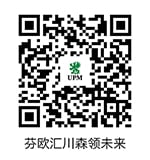We drive changes in attitudes and practices, aiming to effect permanent change towards the circular economy.
Recovered materials benefit enviroment and economy
Recovered materials are becoming more valuable than ever
We aim to use valuable and renewable forest biomass as responsibly and efficiently as possible. The circular bioeconomy is an economic model in which materials and value circulate and added value is generated by services and smart operations.
In the forest industry, the circular bioeconomy might sound like nothing more than a new name for the operating model that we have been developing for years. However, on a wider scale, the circular way of thinking creates new business opportunities for us, as it combines environmental and economic targets. We are actively involved in the development of the bioeconomy and in the economic and industrial revolution based on it. Our sustainable product design concept that we have incorporated into product and process development is an excellent example of responsible business practices.
UPM is one of the world’s largest users of graphic recovered paper
We are one of the world’s leading users of recovered paper for the production of graphic paper. In 2023 the use was approximately 0.8 million tonnes. We maximise resource efficiency and prolong the lifecycle of our products through recycling.
Efficient paper recycling depends on the local infrastructure for national collection schemes and recovery systems. The recovered paper we use is purchased from Europe, where the most significant suppliers are local municipal authorities, waste management companies and printing houses. We aim to optimise the value chain of recovered paper by focusing on local supply close to the mills with minimal costs and environmental impact.
Resource efficiency saves raw materials both during production and at the end of the lifecycle: paper does not generate waste as it can be recycled into a raw material. Paper can be recycled up to six times after its first use, and even after the fibres wear out, they can still be used to generate renewable bioenergy.
We received the first EU Ecolabel for newsprint since the criteria were approved in 2012. To meet the criteria, the paper must be produced using at least 70% recovered fibres.
The share of recycled fibre represents one third of all fibre raw materials used in our paper production.
From ash to a variety of products
Ash resulting from bioenergy production forms the most significant proportion of our solid waste. Ash is used on a large scale in various applications ranging from landscaping to road building.
